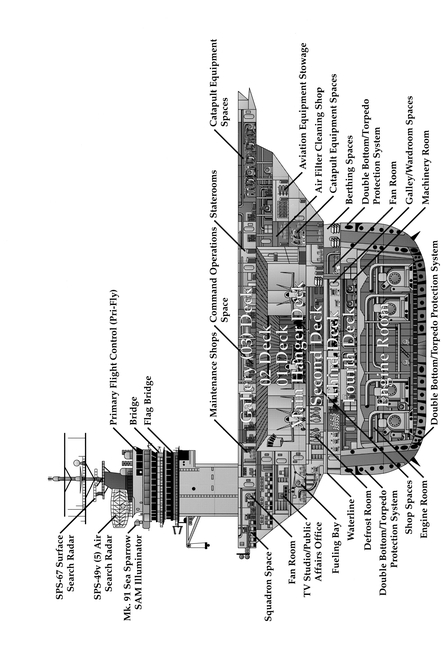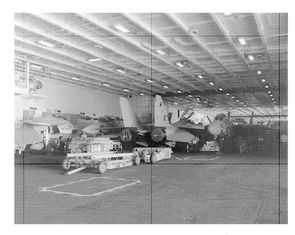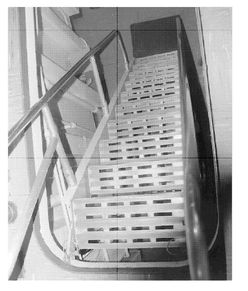Carrier (1999) (23 page)
Authors: Tom - Nf Clancy

The
Nimitz
Class: A Guided Tour



Nimitz
Class: A Guided Tour
Let’s now take a short walking tour of a
Nimitz-
class carrier. We’ll start the way most guests come aboard, at the officers’ accommodation brow on the starboard side just under the island. One of the first things you notice is the thickness of the hull, which is composed of high-strength steel several inches thick. It is that thick to protect against battle damage and fires. The same material makes up the flight and hangar decks, providing them with a similar resistance to damage and fires. Everywhere, there are redundant water and firefighting mains, with damage control stations in every passageway. The Navy is deadly serious about firefighting, and there even is a water deluge system, which can flood the deck, or wash it down in the event of a nuclear or chemical attack.
Nimitz-
class carrier. We’ll start the way most guests come aboard, at the officers’ accommodation brow on the starboard side just under the island. One of the first things you notice is the thickness of the hull, which is composed of high-strength steel several inches thick. It is that thick to protect against battle damage and fires. The same material makes up the flight and hangar decks, providing them with a similar resistance to damage and fires. Everywhere, there are redundant water and firefighting mains, with damage control stations in every passageway. The Navy is deadly serious about firefighting, and there even is a water deluge system, which can flood the deck, or wash it down in the event of a nuclear or chemical attack.

A front cutaway view of an improved
Nimitz
-class (CVN-68) nuclear-powered aircraft carrier.
Nimitz
-class (CVN-68) nuclear-powered aircraft carrier.
JACK RYAN ENTERPRISES, LTD., BY LAURA DENINNO
Past the entryway hatch, you take the first of many tall steps over structural members the crew calls “knee knockers.” Though they are a constant nuisance to movement throughout the ship, these steel thresholds provide structural strength to the entire vessel. A
Nimitz
has miles of virtually indistinguishable passageways. And there are dozens of places in them where just standing around watching can be hazardous—due to noise, fumes, moving machinery, or simply wet, slippery decks. These passageways are considerably narrower than those in other combat vessels, particularly amphibious ships which have room for combat-loaded Marines to move around. Despite their huge size, carriers are volume-limited, and space for people to live, work, and walk takes away capacity for fuel, bombs, and fighting power. So getting around with any sort of load can be a genuine chore. You often see “bucket brigades” of sailors moving loads of food and other supplies from one place to another.
Nimitz
has miles of virtually indistinguishable passageways. And there are dozens of places in them where just standing around watching can be hazardous—due to noise, fumes, moving machinery, or simply wet, slippery decks. These passageways are considerably narrower than those in other combat vessels, particularly amphibious ships which have room for combat-loaded Marines to move around. Despite their huge size, carriers are volume-limited, and space for people to live, work, and walk takes away capacity for fuel, bombs, and fighting power. So getting around with any sort of load can be a genuine chore. You often see “bucket brigades” of sailors moving loads of food and other supplies from one place to another.
The narrow corridors are one important reason for the Navy’s constant emphasis on simple courtesy. A senior officer or chief headed in the opposite direction always gets a respectful greeting and the right of way in these narrow passages. I learned a valuable lesson sometime ago from a civilian analyst who had spent many years on board Navy ships: “If you’re standing anywhere and you’re not touching metal, you’re probably in somebody’s way.”
Moving inboard through several hatches, you emerge into the vast hangar deck; 684 feet/208.5 meters long, 108 feet/33 meters wide, and 25 feet/ 7.6 meters tall—about two-thirds the total length of the ship. Three immense sets of power-driven sliding armored doors divide the hangar bay into zones, to limit the spread of a fire or damage from explosions. In good weather, daylight floods in from four huge oval openings in the sidewalls where the elevators are located. In bad weather sliding barriers seal off the elevator openings to keep the interiors safe and dry. The elevators themselves are the largest aluminum structures on the ship (to save weight). Each of these mammoth lifts (one on each side aft, with two others forward on the starboard side) can raise two fully loaded F-14 Tomcats (the heaviest carrier aircraft) to the flight deck at one time. This is one of the few places on the ship where you can actually see the sea and sky, and remind yourself of the outside world. The flight deck, by contrast, is a highly restricted area. Since there are no portholes, most of the crew rarely sees the light of day. You often find crew members who go days and weeks at a time without either a breath of fresh air or a view of the outside world.
The hangar deck is one of the three main horizontal structures on a carrier (the flight deck and keel/double bottom are the other two), and it provides much of the stiffness and protection for the rest of the ship. Any damage from hits on a carrier should be contained outside the armored boxes that surround the hangar deck and engineering/living spaces below. When it’s empty, you would have room to play two games of American football in the hanger bay. But when it’s filled with fifty or sixty aircraft only inches apart, there is barely room to worm your way through the mass of landing gear, pylons, and maintenance equipment. The hangar deck is always packed with airplanes and equipment, though there is not enough room to strike down all of the air wing’s birds at one time. This means that some of the birds must always be parked on the flight deck. Fortunately, Naval aircraft are designed to withstand the corrosive effects of salt water, and can take the punishment fairly well.
Just aft of the elevator bay is a large stowage area where the ship’s boats are stacked, along with bulky items like forklifts, spare arresting cable reels, and spare engines. Moving aft from this holding area, you find the engine and maintenance shops, which completely fill the stern of the ship. Here the ship’s Aircraft Intermediate Maintenance Division (AIMD) repairs, overhauls, and tests engines, hydraulic pumps, electronics boxes, and countless other mechanical components that keep planes flyable and combat-ready. The maintenance shops are divided up into small spaces where work is done that normally takes acres of workshops and hangars back ashore.
Farther aft of the AIMD shops, you again break out into daylight on the stern, or fantail, of the ship, an open area the full width of the hull, roofed by the flight deck, with projecting platforms and catwalks on either side. Mounted on the fantail are massive test stands, where aircraft engines can be strapped down and run at full power. Because no bit of open space goes to waste on a carrier, you’ll only rarely find a time when you can just stand back here and watch the ocean go by. This is especially true during flight operations. If an aircraft should hit the stern (in what aviators dryly call a “ramp strike”), the fantail is going to be showered with flaming jet fuel and debris. Such accidents are very rare, but they
do
happen, which means that unless you work there, you aren’t permitted on the fantail. So if you get to see this spot while under way, count yourself lucky.
do
happen, which means that unless you work there, you aren’t permitted on the fantail. So if you get to see this spot while under way, count yourself lucky.

The hangar bay of the USS
George Washington
(CVN-73), a
Nimitz
-class (CVN-68) carrier.
George Washington
(CVN-73), a
Nimitz
-class (CVN-68) carrier.
JOHN D. GRESHAM
Here also are one of the four (three on the
Nimitz
(CVN-68),
Dwight D. Eisenhower
(CVN-69), and
Carl Vinson
(CVN-70)) Mk. 15 Phalanx Close-In Weapons Systems (CIWS). A pedestal-mounted 20mm Gatling gun with its own tracking radar, the Mk. 15 is designed to knock down incoming missiles and aircraft. Phalanx has now been in service for almost twenty years, and is considered marginal against the latest threat systems (like the sea-skimming, Mach 2 Russian Kh-41/SS-N-22 Sunburn missile). The Mk. 15’s will eventually be replaced by twenty-one-round launchers for the Rolling Airframe Missile (RIM-116A RAM). RAM is based on the classic AIM-9 Sidewinder air-to-air missile, with a modified seeker from a Stinger (FIM-92) man- portable SAM. RAM—much more capable than the Mk. 15—can actually destroy an incoming Mach 2 missile before it hits (or showers the ship with supersonic fragments).
Nimitz
(CVN-68),
Dwight D. Eisenhower
(CVN-69), and
Carl Vinson
(CVN-70)) Mk. 15 Phalanx Close-In Weapons Systems (CIWS). A pedestal-mounted 20mm Gatling gun with its own tracking radar, the Mk. 15 is designed to knock down incoming missiles and aircraft. Phalanx has now been in service for almost twenty years, and is considered marginal against the latest threat systems (like the sea-skimming, Mach 2 Russian Kh-41/SS-N-22 Sunburn missile). The Mk. 15’s will eventually be replaced by twenty-one-round launchers for the Rolling Airframe Missile (RIM-116A RAM). RAM is based on the classic AIM-9 Sidewinder air-to-air missile, with a modified seeker from a Stinger (FIM-92) man- portable SAM. RAM—much more capable than the Mk. 15—can actually destroy an incoming Mach 2 missile before it hits (or showers the ship with supersonic fragments).
Located below the Phalanx mount are the twin ports for the ships SLQ-25A “Nixie” torpedo countermeasures system. Nixie is a towed noisemaker streamed behind the ship when there is a threat of incoming torpedoes. The idea is that the “fish” will chase the towed decoy, and detonate against it instead of the ship. Since each decoy can be used only once, two Nixie decoys are kept at the ready, each at the end of a spooled tether in the stern. Finally, on a platform at the stem next to the Mk. 15 stands the instrument landing system. This is a stabilized “T”-shaped bar of vertical and horizontal lights, which helps a pilot on final approach judge the roll and motion of the ship.
Heading back forward into the hangar bay, you will probably notice the “spongy” feel of the deck, which comes from the grayish-black non-skid coating that is applied to seemingly every horizontal surface exposed to the weather. Non-skid—a mix of abrasive grit and synthetic rubber applied in a rippled pattern—keeps you from slipping on a wet, oily, or tilted deck, an all too common occurrence on a naval vessel. Up on the flight deck, the constant pounding and scraping of landing gear and tailhooks quickly erode the coating and expose bare steel. When this happens, maintenance crews mix up a batch and “touch up” worn spots. Also notable is the hangar deck’s elaborate fire-suppression system, which can put enough foam into the hangar bay to drown the unwary. Fire hoses and mains sprout from every corner of the hangar bay, and damage control gear is also in evidence.
Looking down into the well of one of the hundreds of ladders aboard a
Nimitz
-class (CVN-68) carrier. These are tall and narrow, and are quite grueling to climb.
Nimitz
-class (CVN-68) carrier. These are tall and narrow, and are quite grueling to climb.
JOHN D. GRESHAM

In the overhead are storage racks for everything from aircraft drop tanks to spare engines. You can even see a spare catapult piston—a steel forging as long as a bus—racked high on the wall of the hangar bay. In the forward part of the hangar bay on the starboard side are two more aircraft elevators, as well as the passageways that lead into the forecastle. Here you find more AIMD offices and shops, as well as most of the berthing spaces for enlisted personnel from the embarked air wing. Cramming almost six thousand personnel into a ship, even though it’s close to a quarter mile long, makes for tight quarters. Even so, the enlisted and chiefs’ berthing spaces on a
Nimitz
are still more comfortable than those aboard a submarine or older Navy surface warship.
Nimitz
are still more comfortable than those aboard a submarine or older Navy surface warship.
For a young person coming aboard a warship for the first time, the cramped personal space may seem harsh. In fact, while personal space is spartan, it is nevertheless quite functional. Enlisted personnel get a stowage bin under their bunks, and a single upright locker about the size of the one you had back in high school. They can also stow some personal items in their workspaces, but they still must always plan ahead when packing to go aboard ship. For sleeping, crew will normally be assigned to a bunk (called a “rack”), which will be one in a stack of three. You will find around sixty racks in a berthing space, with an attached rest room/shower facility (what the Navy calls a “head”), and a small common area with a table, chairs, and television connected to the ship’s cable system. Television monitors can be found in almost every space on board, displaying everything from the ship’s Plan of the Day (called the “POD”), to movies, CNN Headline News, and the “plat cams”—a series of television cameras that monitor activities on the flight deck.
The racks themselves are narrow single beds, with a comfortable foam-rubber mattress, and basic bedding. There are also privacy curtains, a small reading lamp, and usually a fresh-air vent—often a vital necessity. While most of the interior spaces of a
Nimitz
are air-conditioned, even nuclear-powered chillers sometimes have a hard time keeping up with the hot and humid conditions in the Persian Gulf or the Atlantic Gulf Stream in summer. That stream of cool air on your face is sometimes all that lets you sleep. Other distractions on board can also keep you from getting rest, such as the launching and landing of high-performance combat aircraft on the roof. Crew members with quarters just below the catapults and arresting gear have a hard time sleeping when night flight operations are running, which is why the air wing personnel are berthed here. When the wing is flying, they would not be in their racks anyway.
Nimitz
are air-conditioned, even nuclear-powered chillers sometimes have a hard time keeping up with the hot and humid conditions in the Persian Gulf or the Atlantic Gulf Stream in summer. That stream of cool air on your face is sometimes all that lets you sleep. Other distractions on board can also keep you from getting rest, such as the launching and landing of high-performance combat aircraft on the roof. Crew members with quarters just below the catapults and arresting gear have a hard time sleeping when night flight operations are running, which is why the air wing personnel are berthed here. When the wing is flying, they would not be in their racks anyway.
Other books
Face of Betrayal by Lis Wiehl
Modern Sorcery: A Jonathan Shade Novel by Gary Jonas
Of All the Stupid Things by Alexandra Diaz
Spencerville by Nelson Demille
Apricot brandy by Lynn Cesar
Glass - 02 by Ellen Hopkins
The Luna Deception by Felix R. Savage
Family In The Making (Matchmakeing Babies 2) by Jo Ann Brown
SEDUCED BY THE STRANGER (Dirty Little Secrets, #1) by Alex Elliott
Daphne's Book by Mary Downing Hahn
